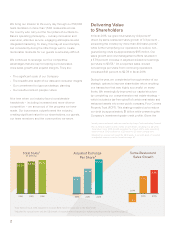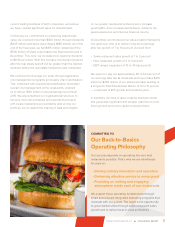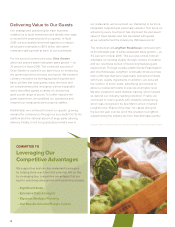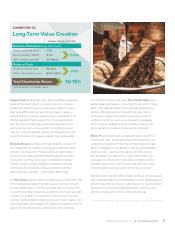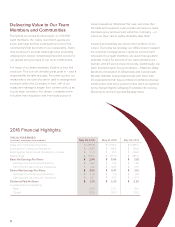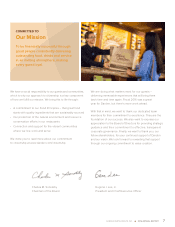Red Lobster 2016 Annual Report Download - page 14
Download and view the complete annual report
Please find page 14 of the 2016 Red Lobster annual report below. You can navigate through the pages in the report by either clicking on the pages listed below, or by using the keyword search tool below to find specific information within the annual report.
MANAGEMENT’S DISCUSSION AND ANALYSIS
OF FINANCIAL CONDITION AND RESULTS OF OPERATIONS
DARDEN
10
This discussion and analysis below for Darden Restaurants, Inc. (Darden, the
Company, we, us or our) should be read in conjunction with our consolidated
financial statements and related financial statement notes found elsewhere
in this report. We operate on a 52/53-week fiscal year, which ends on the
last Sunday in May. Fiscal 2016, which ended May 29, 2016, consisted of
52 weeks. Fiscal 2015, which ended May 31, 2015, consisted of 53 weeks
and fiscal 2014, which ended May 25, 2014, consisted of 52 weeks.
OVERVIEW OF OPERATIONS
Our business operates in the full-service dining segment of the restaurant
industry. At May 29, 2016, we operated 1,536 restaurants through
subsidiaries in the United States and Canada under the Olive Garden®,
LongHorn Steakhouse®, The Capital Grille®, Yard House®, Bahama Breeze®,
Seasons 52®, and Eddie V’s Prime Seafood® and Wildfish Seafood Grille®
(collectively, Eddie V’s) trademarks. We own and operate all of our restau-
rants in the United States and Canada, except for 6 joint venture restaurants
managed by us and 18 franchised restaurants. We also have 32 franchised
restaurants in operation located in Latin America, the Middle East and
Malaysia. All intercompany balances and transactions have been eliminated
in consolidation.
On November 9, 2015, we completed the spin-off of Four Corners
Property Trust, Inc. (Four Corners) with the pro rata distribution of one share
of common stock for every three shares of Darden common stock to
Darden shareholders. The separation included (i) the transfer of 6 LongHorn
Steakhouse restaurants located in the San Antonio, Texas area as well as
418 restaurant properties to Four Corners, which were subsequently leased
back to Darden; (ii) the issuance to us of all of the outstanding common
stock of Four Corners and corresponding pro rata distribution to our
shareholders of the outstanding shares of Four Corners common stock
as a tax-free stock dividend; and (iii) a cash dividend of approximately
$315.0 million received by us from Four Corners from the proceeds
of Four Corners’ term loan borrowings. See Note 2 to our consolidated
financial statements for further details.
We believe that capable operators of strong, multi-unit brands have the
opportunity to increase their share of the restaurant industry’s full-service
segment. Generally, the restaurant industry is considered to be comprised
of three segments: quick service, fast casual, and full service. All of our
restaurants fall within the full-service segment, which is highly fragmented
and includes many independent operators and small chains. We believe we
have strong brands and that the breadth and depth of our experience and
expertise sets us apart in the full-service segment of the restaurant industry.
This collective capability is the product of investments over many years in
areas that are critical to success in our business, including restaurant
operations excellence, brand management excellence, supply chain, talent
management and information technology, among other things.
With a focus on growing same-restaurant sales, we’ve implemented a
“Back-to-Basics” approach rooted in strong operating fundamentals. We’re
focused on improving culinary innovation and execution inside each of our
brands, delivering attentive service to each and every one of our guests,
and creating an inviting and engaging atmosphere inside our restaurants.
We support these priorities with smart and relevant integrated marketing
programs that resonate with our guests. By delivering on these operational
and brand-building imperatives, we expect to increase our market share
through new restaurant and same-restaurant sales growth and deliver
best-in-class profitability.
The Darden support structure enables our brands to achieve their
ultimate potential by: (1) driving advantages in supply chain and general and
administrative support; (2) applying insights collected from our significant
guest and transactional databases to enhance guest relationships and
identify new opportunities to drive sales growth; and (3) relentlessly driving
operating efficiencies and continuous improvement, operating with a sense
of urgency and inspiring a performance-driven culture.
We seek to increase profits by leveraging our fixed and semi-fixed costs
with sales from new restaurants and increased guest traffic and sales at
existing restaurants. To evaluate our operations and assess our financial
performance, we monitor a number of operating measures, with a special
focus on two key factors:
• Same-restaurant sales – which is a year-over-year 52-week
com parison of each period’s sales volumes for restaurants open at
least 16 months, including recently acquired restaurants, regardless
of when the restaurants were acquired; and
• Segment profit – which is restaurant sales, less food and beverage
costs, restaurant labor costs, restaurant expenses and marketing
expenses (sometimes referred to as restaurant-level earnings).




